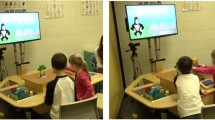Abstract
This paper focuses on children creating representations on paper for situations that change over time. We articulate the distinction between homogeneous and heterogeneous spaces and reflect on children's tendency to create hybrids between them. Through classroom and interview examples we discuss two families of tasks that seem to facilitate children's development of homogeneous spaces: 1) Making selected features directly visible, instead of requiring intermediate steps and calculations; for example, to be able to directly compare different sets of data combined in a single graph, and 2) Exploring well-defined figural components that can be used in graphing, such as line segments or sequencing from left to right, that are introduced as a resource.
Similar content being viewed by others
REFERENCES
Bakhtin, M.M.: 1981, The Dialogic Imagination: Four Essays, University of Texas Press, Austin, TX.
Bamberger, J.: 1988, ‘Les structurations cognitives de l'appréhension et de la notation de rythmes simples’, in H. Sinclair (ed.), La Production de Notations chez le Jeune Infant, Presses Universitaires de France, Paris.
Bednarz, N., Dufour-Janvier, B., Poierier, L. and Bacon, L.: 1993, ‘Socioconstructivist viewpoint in the use of symbolism in mathematics education’, Alberta Journal of Educational Research 1(39), 41–58.
Carrol, L.: 1998, Alice in Wonderland, Oxford University Press, Oxford, UK.
Casey, E.: 1997, The Fate of Place. A Philosophical History, University of California Press, Berkeley, CA.
Casey, E.S.: 1987, Remembering. A Phenomenological Study, Indiana University Press, Bloomington and Indianapolis, IN.
DiSessa, A.: 1999, Students’ Criteria for Representational Adequacy, Graduate School of Education University of California, Berkeley, CA.
DiSessa, A., Hammer, D., Sherin, B. and Kolpakowski, T.: 1991, ‘Inventing graphing: Meta-representational expertise in children’, The Journal of Mathematical Behavior 10(2), 117–160.
Ferreiro, E. and Teberosky, A.: 1979, Literacy before Schooling, Heinemann, Exeter, NH.
Gassendi, P.: 1658/1972, The Selected Works of Pierre Gassendi, Johnson Reprint Corporation, New York, NY.
Kaput, J.: 1998, ‘Representations, inscriptions, descriptions of learning: A kaleidoscope of windows’, Journal of Mathematical Behavior 17(2), 265–281.
Karmiloff-Smith, A.: 1979, ‘Micro-and macro-developmental changes in language acquisition and other representational systems’, Cognitive Science 3, 91–117.
Krabberdam, H.: 1982, The Nonquantitative Way of Describing Relations and the Role of Graphs, Paper presented at the Conference on Functions, Enschede, the Netherlands.
Lehrer, R., Schauble, L., Carpenter, S. and Penner, D.: 2000, ‘The interrelated development of inscriptions and conceptual understanding’, in P. Cobb, E. Yackel and K. McClain (eds.), Symbolizing and Communicating in Mathematics Classrooms. Perspectives on Discourse, Tools, and Instructional Design, Lawrence Erlbaum Associates, Mahwah, NJ.
Lehrer, R., Strom, D. and Confrey, J.: Submitted, Grounding metaphors and inscriptional resonance: Children's emerging understanding of mathematical similarity.
Levine, J.: 1983, ‘Materialism and qualia: The explanatory gap’, Pacific Philosophical Quarterly 64, 354–361.
Lewontin, R.: 2000, The Triple Helix, Harvard University Press, Cambridge, MA.
Lincoln, Y.S. and Guba, E.G.: 1985, Naturalistic Inquiry, Sage Publications, Beverly Hill, CA.
Mesquita, A.L.: 1998, ‘On conceptual obstacles linked with external representations in geometry’, Journal of Mathematical Behavior 17(2), 183–195.
Monk, S.: 2000, ‘Representation in school mathematics: Learning to graph and graphing to learn’, in J. Kilpatrick, W.G. Martin and D.E. Schifter (eds.), A Research Companion to Principles and Standards for School Mathematics, National Council of Teachers of Mathematics, Washington, DC.
Nagel, T.: 1970, ‘What is it like to be a bat?’ Philosophical Review 79, 394–403.
Nemirovsky, R.: 1996, ‘Mathematical narratives’, in N. Bednarz, C. Kieran and L. Lee (eds.), Approaches to Algebra: Perspectives for Research and Teaching, Kluwer Academic Publishers, Dordrecht, The Netherlands, pp. 197–223.
Nemirovsky, R. and Monk, S.: 2000, ‘“If you look at it the other way...:” An exploration into the nature of symbolizing’, in P. Cobb, E. Yackel and K. McClain (eds.), Symbolizing and Communicating in Mathematics Classrooms: Perspectives on Discourse, Tools, and Instructional Design, Lawrence Erlbaum, Hillsdale, NJ.
Nemirovsky, R., Tierney, C. and Wright, T.: 1998, ‘Body motion and graphing’, Cognition and Instruction 16(2), 119–172.
Noble, T., Nemirovsky, R., Wright, T. and Tierney, C.: 2001, ‘Experiencing change: The mathematics of change in multiple environments’, Journal for Research in Mathematics Education 32(1), 85–108.
Ochs, E., Gonzales, P. and Jacoby, S.: 1996, ‘When I come down I'm in the domain state: Grammar and graphic representation in the interpretive activity of physicists‘, in E. Ochs, E.A. Schegloff and S. Thompson (eds.), Interaction and Grammar, Cambridge University Press, Cambridge.
Ochs, E., Jacoby, S. and Gonzales P.: 1994, ‘Interpretive journeys: How physicists talk and travel through graphic space’, Configurations 2(1).
O'Keefe, J. and Nadel, L.: 1978, The Hippocampus as a Cognitive Map, Clarendon Press, Oxford, UK.
Paillard, J.: 1991, Brain and Space, Oxford University Press, Oxford, UK.
Poincare, H.: 1905/1952, Science and Hypothesis, Dover Publications, New York, NY.
Sherin, B.: 1997, How Students Invent Representations of Motion: A Genetic Account, Paper presented at the Annual Meeting of the American Educational Research Association, Chicago, IL.
Tierney, C., Nemirovsky, R. and Weinberg, A.: 1994, Changes: Up and Down the Number Line, Curricular unit for grade 3, Dale Seymour Publications, Menlo Park, California.
Tierney, C., Weinberg, A. and Nemirovsky, R.: 1994, Graphs: Changes Over Time, Curricular unit for grade 4, Dale Seymour Publications, Menlo Park, California.
Whitehead, A.N.: 1926/1997, Science and the Modern World, The Free Press, New York, NY.
Wittgenstein, L.: 1953, Philosophical Investigations, Macmillan, New York, NY.
Author information
Authors and Affiliations
Rights and permissions
About this article
Cite this article
Nemirovsky, R., Tierney, C. Children creating ways to represent changing situations: On the development of homogeneous spaces. Educational Studies in Mathematics 45, 67–102 (2001). https://doi.org/10.1023/A:1013806228763
Issue Date:
DOI: https://doi.org/10.1023/A:1013806228763




